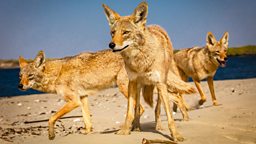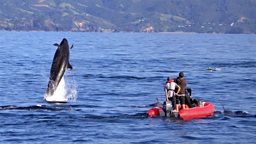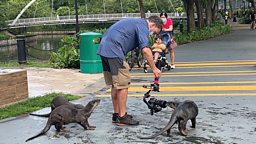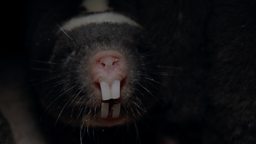Filming a humpback whale calf kidnap
By Mammals Producer, Daniel Rasmussen

The north-western Australian town of Exmouth has, for a long time, been little more than a military outpost, and is currently home to a listening station that stands proud on a headland looking like a geometric alien spaceship has landed. The land immediately surrounding is desert, wild and endless. It’s an exciting juxtaposition, the modern and impossibly huge alongside the untouched. It’s a long journey to get there from the UK, with the last leg made by jumping on board a small plane filled with electricians, miners and other tradespeople bussed in for shifts in this remote region of Australia.
orca arrive to hunt the humpback calves, sometimes killing as many as five a day
But there is another big pull to the place. Off the coast lies a coral reef; Ningaloo, the largest fringing reef on earth spanning around 250km. The reef and surrounding sea is thought to be the birthing place of a rapidly growing population of humpback whales. Animals once hunted to just a few hundred here have rebounded in a few decades to around 35,000 and counting. Truly one of the greatest conservation success stories of all. Despite the setting, there is actually very little to eat here for the humpbacks. Warm waters are low in nutrients and oxygen and as such hold little resource for whales that feed on plankton. But they do offer safety and the water temperature is ideal for newborns. But eventually hunger drives them to start an epic migration, all the way to Antarctica where food is abundant. By the time they leave, the young have had a brief chance to develop their swimming skills and grow a little from their mother’s rich milk. But once outside of the fringing reef, they are vulnerable.
John Totterdell has been studying the orca of Exmouth for 30 years. He has identified and worked out which are related to which and follows the lives of the family pods that visit the area during their brief appearances, which are timed to coincide with the months of humpback migration. There aren’t many orca – under 40 individuals, so finding them amongst the 30-odd thousand whales is the biggest hurdle. Fortunately, local light aircraft and boats call in sightings for John to investigate. His mission is to ascertain just how well these orca are doing. On first glance, it would seem good. The orca arrive to hunt the humpback calves, sometimes killing as many as five a day, and leave large amounts of those carcasses to sink away uneaten. But his findings are proving a concern. It's thought that no new calves have been born for many years, the adults are slowly disappearing, or at least not returning. Familiar family groups are splinted to new groups. There are many questions, but few answers.
On the water, in my previous visits to the area, every hunt has worked the same way… A pod of orca surprise and attack a mother and her calf, some mothers fight tooth and nail to save their babies, some put up less resistance. Some calves live, some do not. Occasionally adult males escort the mothers and in these instances the orca win less often. The humpbacks have other tactics like hugging the shallows and reef periphery making it hard for the orca to surprise or get the speed up to attack them. The survival of the fittest is easy to see in action, but ultimately the majority of calves make it through the ambush zone and onto Antarctica where they can feed.

For the orca, so few in number, every hunt carries a risk. Each swing of the humpbacks’ fins could injure them reducing their ability to find a meal next time. The orca rely on each other, each having a job in the attack, without numbers winning is difficult. Their tactics have been consistent. Some, principally the smaller ones, distract the humpback mother whilst the large male orca use their heads like battering rams to kill the young humpbacks.

Our team was equipped with equipment not used here before, in particular a robust, stabilised underwater camera rig that was purpose built to be able to film underwater at high speed and give new insights into how the orca work together, using their mammalian intelligence and communication to overcome an adversary many times their size.
So, when we encountered a group of just three orca intercepting a mother humpback and her calf, along with an adult male escort, we expected to see little or no action. But as our drone tracked the humpbacks, the orca executed an entirely new tactic, one never seen before by the scientists and filmed by the camera team for the very first time… The orca kidnapped the calf.
After following the humpbacks, and waiting for the right opportunity, the three orca seized the calf at speed. Our boat moved in to film the action under the surface, uncovering the remarkable physics of the kidnap. The orca take the calf away by carrying it in their slipstream, with it riding on the wake behind their fins. This completely new methodology shocked the crew and underlined just how incredible mammals are; when presented with a problem they can design, communicate and execute a plan as a team.
This new behaviour may simply be an evolution of tactics in the light of falling orca numbers here, or they could be old behaviours, rising again now that whale numbers have recovered post the ban on commercial whaling. John has yet to find a concrete answer. But it's exciting that one of our greatest living predators, and one of most intelligent animals on earth, is still surprising us, and it is the work of John and other scientists that enables us to share in these remarkable stories, and by working in partnership with the Βι¶ΉΤΌΕΔ, our shared observations can be used to try and better understand these remarkable mammals.

Humpback calf kidnap
Off the coast of Western Austraila, orca have specialised in hunting humpback calves.




























